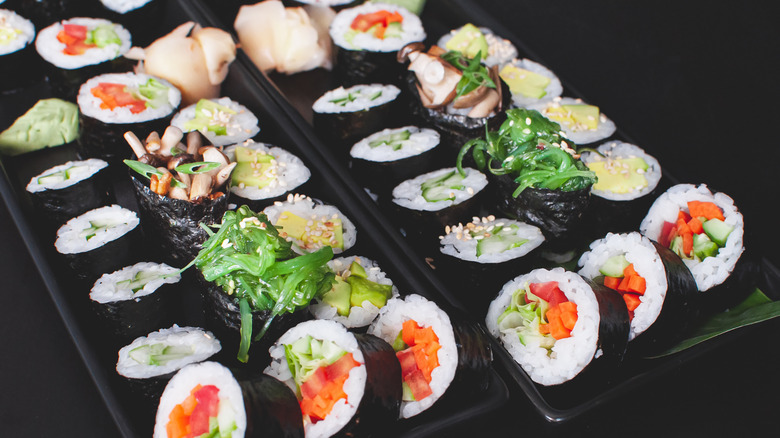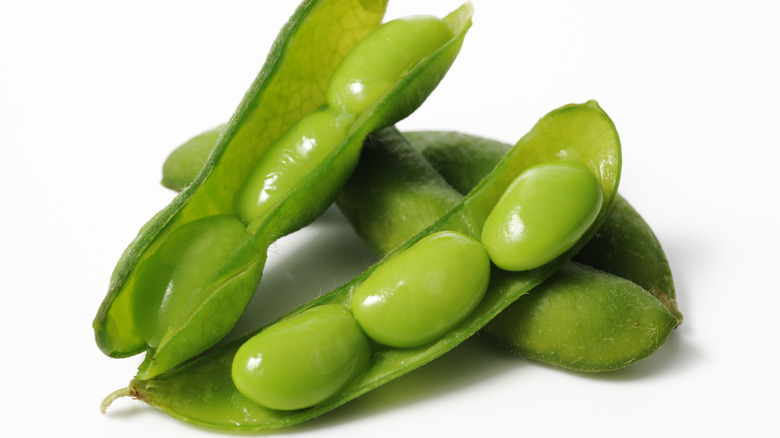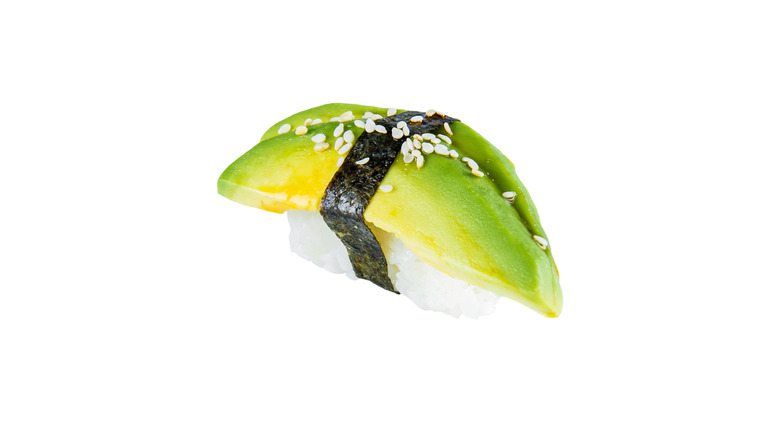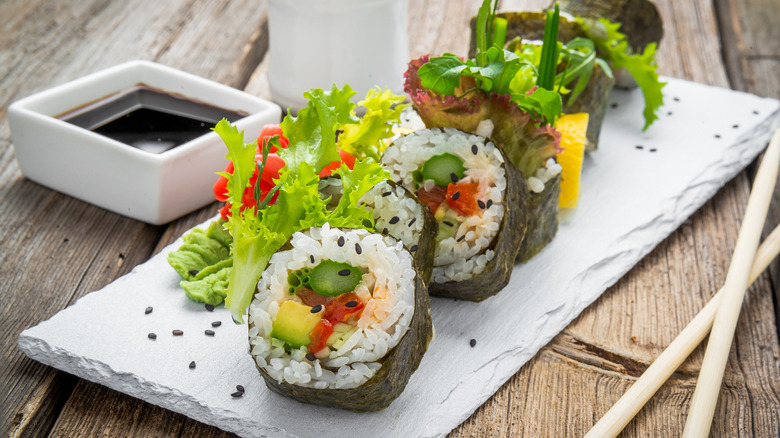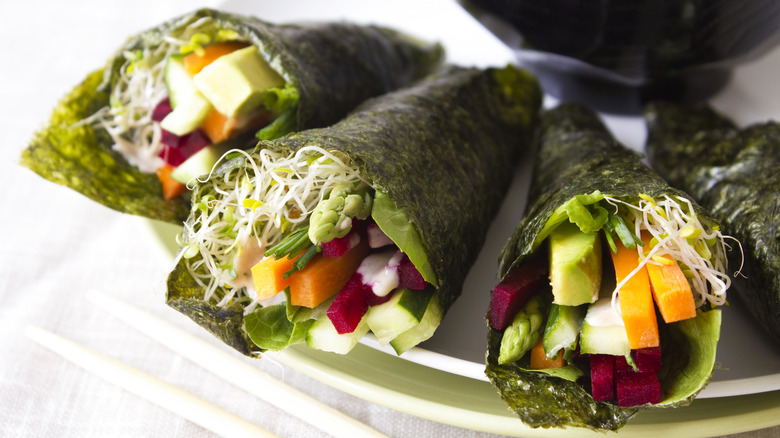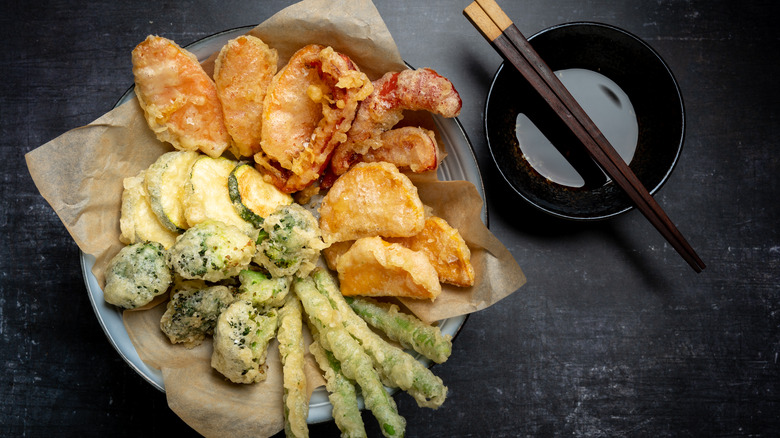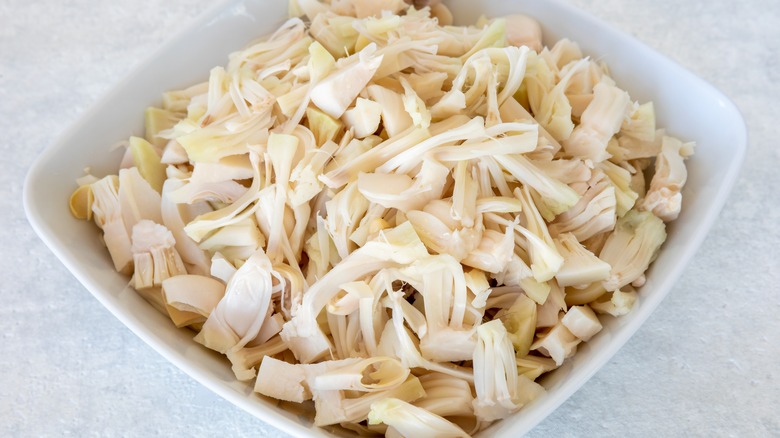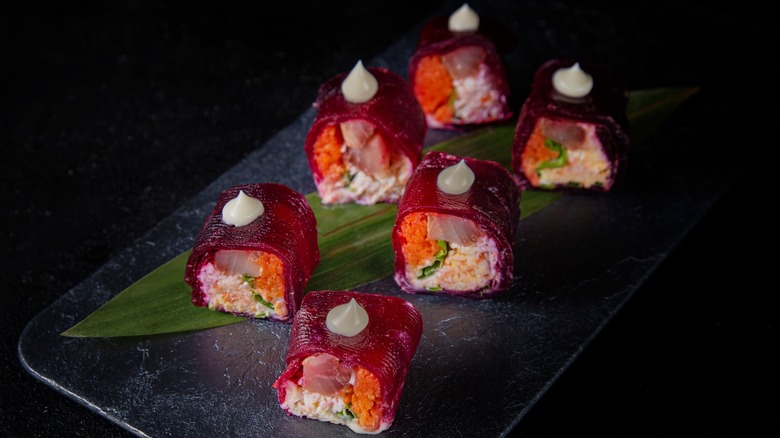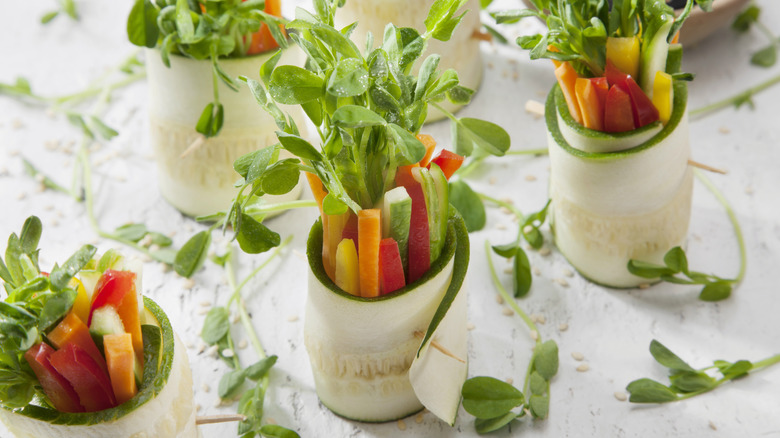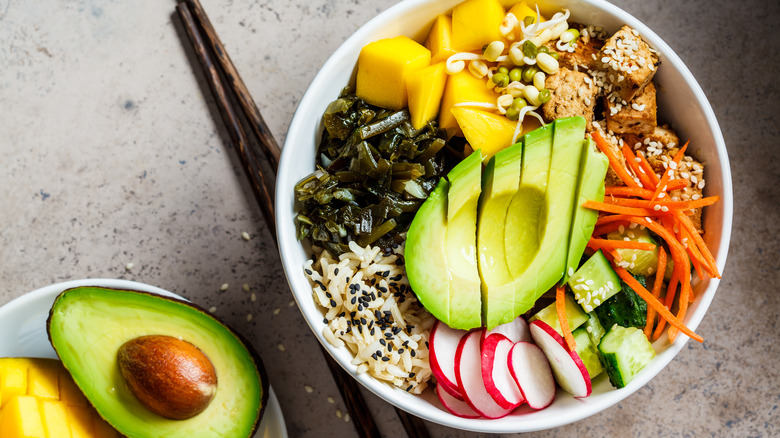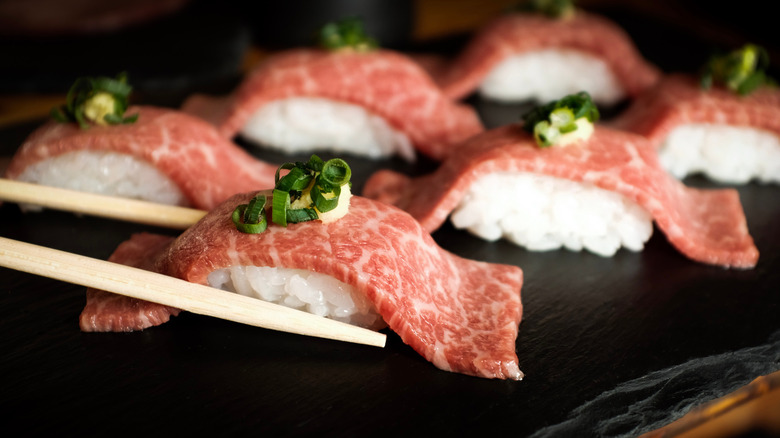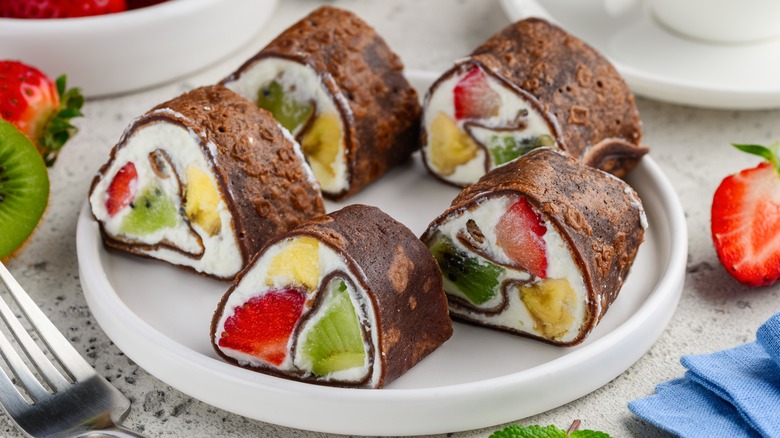11 Different Ways To Enjoy Fish-Free Sushi
Raw fish is the first thing that comes to mind when most people think of sushi. But what if you don't like or can't eat fish? Whether you're vegan, vegetarian, allergic, or simply don't like fish and other kinds of seafood, there are plenty of delicious sushi options for you to enjoy.
Fortunately, sushi is actually much more versatile than raw fish alone, and there are many ways to enjoy fish-free sushi ranging from classic to inspired. From vegetables to fake "meat" to unconventional wrapping methods and unique ingredients, there's a world of delectable fish-free sushi options to explore. There's even dessert sushi for when you crave fresh fruit or want something sweet.
Keep reading to learn all about fish-free sushi and its many forms, so you can make delicious sushi at home that perfectly suits your taste — or so you can order correctly on your next trip to a Japanese restaurant.
Use soy paper instead of seaweed
Have you ever bitten into a piece of a vegan sushi roll and thought that it still tastes fishy? Chances are, it's from the seaweed wrapping. It makes sense when you think about it. After all, seaweed grows in the ocean, which, duh, is where fish live! Don't worry, though. Soy paper makes a great alternative.
Seaweed paper, also called nori, is used in almost every type of sushi roll. While nori is technically vegetarian, it still has a prominent fishy taste, especially if you're averse to that flavor. While some meat-eaters may not notice, people who haven't eaten seafood in a long time will most likely pick up on the flavor.
Soy paper functions just like nori but lacks the fishy taste; yay! Actually, it doesn't have much of a taste at all, so it's super versatile and won't overpower the other ingredients. Soy paper also comes in several fun colors — green and pink, for example — and some are rolled in sesame seeds, which gives them a nice texture.
Unconventional sashimi and nigiri
Sashimi and nigiri are some of the most popular kinds of sushi. Typically they feature a thin slice of fish as the main ingredient. However, you can easily substitute withyummy veggies, like thin slivers of tomato, roasted or marinated red bell pepper, marinated carrot, and more to create the same effect.
Avocado nigiri may be the most well-known type of vegan nigiri. Not only does it pop with color and look incredibly tasty, but the creamy texture of the avocado blends perfectly with sushi rice.
Eggplant, or nasu in Japanese, is a common ingredient in Japanese cuisine, and it makes excellent nigiri. When lightly grilled, it practically melts in your mouth, just like fish. Pickled eggplant has a tangy flavor and chewier texture that also works well.
Mushrooms, like king oyster mushrooms, also make excellent nigiri and sashimi. The bold taste, juicy texture, and appropriate size of shiitake mushrooms are also particularly great for this type of sushi. When lightly cooked and salted with soy sauce, they also have a savory aroma, enhancing the overall experience and flavor.
While egg may not seem intuitive, it's actually the main ingredient of a traditional Japanese dish called Tamagoyaki, which is essentially an omelet. When you place a fluffy egg morsel on top of sushi rice, the result is filling with a light texture.
Marinating your vegetable ingredients in Japanese flavors like ginger and soy also improves authenticity and adds complexity to the flavor. Whichever veggie substitute you choose, add a touch of wasabi on top for a slight kick.
Classic sushi rolls with fresh veggies and avocado
Many authentic Japanese sushi roll recipes are already fish-free. Maybe you've never looked or noticed before, but there is an extensive collection of classic vegan sushi rolls that you can find at almost any sushi restaurant. Instead of fish, they simply contain fresh veggies and avocado. Sometimes, cream cheese is also used, which is super helpful when it comes to keeping pieces intact and adds a creamy texture.
Some of the most common veggies used in classic sushi include cucumber, asparagus, sweet potato, carrot, avocado, and bell pepper. While simple, a cucumber sushi roll can be found on almost every sushi menu. For this configuration, crispy cucumber spears or shredded cucumber are rolled with rice and nori, leading to a crunchy texture and a bright, fresh flavor overall. When dipped in soy sauce or topped with wasabi, it's also got all the flavor needed to evoke classic Japanese cuisine.
The best classic rolls tend to use a mixture of veggies to expand flavor and enhance texture, as is seen in the classic avocado, cucumber, asparagus, and carrot roll.
Easy to make hand rolls
You can use a variety of authentic vegan sushi ingredients to create fish-free hand rolls. Unlike sliced maki rolls, hand rolls have a cone shape. They also allow for a significant increase in filling, which many people prefer. For example, you can fill a veggie hand roll with blanched asparagus, carrots, beets, radish, and sprouts.
Hand rolls are an excellent option for beginner sushi makers as they are often easier to construct, easier to stuff without being too loose, and require less precise slicing. They're also easy to hold and eat without chopsticks — even if they occasionally start falling apart after a few bites.
You can also do this in a larger sushi burrito format. Simply roll your ingredients inside a wrap just like a maki roll, but instead of cutting it into slices, leave it intact as a log. A great thing about sushi burritos is that they keep well in the fridge for a day or two and are easy to take with you to work, hiking, or the park.
Try veggie tempura rolls for additional crunch
Veggie tempura rolls can be made with just about any kind of vegetable or potato, so they're sure to suit all preferences. When veggies are battered and appropriately fried, tempura adds a crunchy element to sushi, which leads to a delicious texture and unending flavor. The tempura batter also soaks up soy sauce when dipped and distributes the salty goodness throughout your sliced roll.
Making authentic tempura is quite simple. All you need to make the batter is water, flour, and egg. After you quickly coat your vegetables with the batter, they'll only need to fry up for a couple of minutes. So don't shy away from the extra steps required. You can even use gluten-free flour to accommodate gluten sensitivities. Pro tip: Let your freshly fried veggies cool for a couple of minutes before layering them up with rice and wrapping them in nori. If you don't, the heat can make the seaweed more fragile, making rolling without tears more difficult. The same is true for other kinds of wraps.
Try making a mushroom tempura roll with spicy mayo or a mixed veggie tempura maki roll or hand roll — trust us, you'll be glad you put in the work required.
Use fake meat
If you enjoy fish and other kinds of seafood and meat but are trying to avoid using the real thing because of an allergy or dietary preference, you can always use an imitation meat product instead. From vegan salmon to vegan shrimp to imitation eel and vegan tuna made with chickpeas, there are a ton of inventive meat substitutes perfect for making sushi. They may be less common than fake chicken or beef, but there are all kinds of fake "seafood" options. Or, you could even try vegan beef, like Beyond or Impossible meat.
Luckily, finding these types of products is becoming easier, and it seems like there is a new version on the market every day. If you have access to an authentic Asian market, you may be surprised at just how many fake "meat" products you can find. Just beware, imitation crab is made with fish, so don't mistake it for a vegan or fish-free option.
While not quite fake meat, tofu, tempeh, and shredded jackfruit are also excellent meat substitutes — tofu is already a super common ingredient in maki rolls and hand rolls. All three substitutes absorb flavor exceptionally well, so it's easy to give them a Japanese flavor profile. They also cook up quickly and easily. Jackfruit even resembles shredded meat and has a similar texture when cooked.
Be adventurous with your veggie and other ingredient selection
In addition to the usual veggies found in classic fish-free sushi, you can also use less traditional ingredients like beets, sprouts, radishes, snap peas, zucchini, and butternut squash to create delicious concoctions. While sprouts and radishes can be added to sushi raw, you'll probably want to marinate beets and slightly cook butternut squash to achieve the right consistency for fish-free sushi. Pickled radishes also make a great choice.
For a lighter option, you can also roll mango or watermelon with avocado in a roll. While unconventional, the blend of textures and mix of sweet and savory flavors is perfect for summer. If you like spicy foods, try adding a jalapeño or another type of hot pepper to the mix as well.
You can also give your sushi a creative twist by substituting cauliflower rice or quinoa for sushi rice. While all three are gluten-free, using these alternatives makes your sushi healthier because both cauliflower and quinoa have a higher nutritional content than rice (via MedicineNet).
Wrap your sushi in raw collard greens, leaf lettuce, or cucumber
For a healthier option with less salt than nori, try using shaved cucumber, raw collard greens, butter lettuce, and other kinds of leafy greens to wrap your sushi. In addition to being healthy, these ingredients can be found in any grocery store and are easy to work with and manipulate. Leafy greens already come in a flat shape convenient for rolling. If you use cucumber slivers, make sure to shave them super thin, and instead of making a long roll to slice into pieces, roll them up one piece at a time.
You can also hollow out a cucumber and use it as a pre-formed wrap. Simply cut a cucumber in half or thirds, hollow out the pulpy center, stuff it with your chosen ingredients, and slice. What's great about this method is that the cucumber shell isn't fragile like a traditional wrap, so it will definitely stay intact. You don't have to roll anything up either, which can be a big perk for inexperienced sushi makers.
Make a sushi bowl
Sushi bowls are the easiest fish-free sushi option because you don't have to fiddle with any kind of wrap or intricate assembly. All you have to do is prep the ingredients and put them in a bowl. It doesn't get much simpler than that. They are also super healthy and allow you to monitor portion size easily and effectively.
Sushi bowls are a kind of free-for-all when it comes to ingredients as long as you use Asian flavors like ginger, soy, and sesame. You can build a hearty sushi bowl with any veggies you like, rice, and much more. For added protein, try edamame, grilled tempeh, or ginger-marinated tofu. Sesame seeds and shredded seaweed also make excellent toppings. Lastly, just like with sushi rolls and hand rolls, sliced avocados add a creamy texture to a bowl. When avocados are used with other seasonings and marinating techniques, you probably won't need any type of dressing or sauce.
Substitute with beef or other kinds of seafood
We've been talking a lot about vegan and vegetarian sushi, but some people simply don't like seafood, even if they eat other kinds of meat. Fortunately for them, some sushi recipes call for tataki, which is Japanese for lightly seared beef. And considering how highly regarded Japanese beef is, this isn't very surprising. According to Beef Loving Texans, pot roast and steak with veggies and rice makes for an outstanding sushi roll. Using beef also makes your sushi tender and juicy, a texture most veggies won't produce.
If you're going to go the meat route, there's also lots of seafood sushi that doesn't contain fish. For example, clam, octopus, scallops, shrimp, squid, and crab are all common sushi ingredients. Some would even say that shrimp and crab are the most popular rolls, especially in the United States, where we aren't as familiar with exotic Japanese fish. So if you don't like fish but still enjoy meat, you have plenty of traditional sushi options to explore.
Finish off a meal with a dessert sushi roll
Dessert sushi rolls are made with fruits, chocolate, and sweet sauces. They make the perfect end to a meal, vegetarian or not. From brownie and crepe wraps to fresh fruit with coconut milk-sweetened rice, the possibilities are nearly endless. You can even deconstruct and reform Oreo cookies to make Oreo sushi, so feel free to get creative.
For super easy dessert sushi, dip a whole banana in chocolate, dust it with crushed pistachio, wait for it to cool, and slice it into sushi-sized pieces. A drizzle of honey or layer of peanut butter also pairs perfectly with banana sushi. Slightly more intricate, chef Tatsuya Yamashita's summer dessert sushi roll includes tropical fruits and avocado. Bonus, dessert sushi like this is often much healthier than traditional desserts.
The more you learn about sushi, the more apparent it becomes that there really aren't any rules, except when you're ordering and eating. While some rolls may not be authentic, they can still be delicious — dessert sushi is a perfect example of this.

